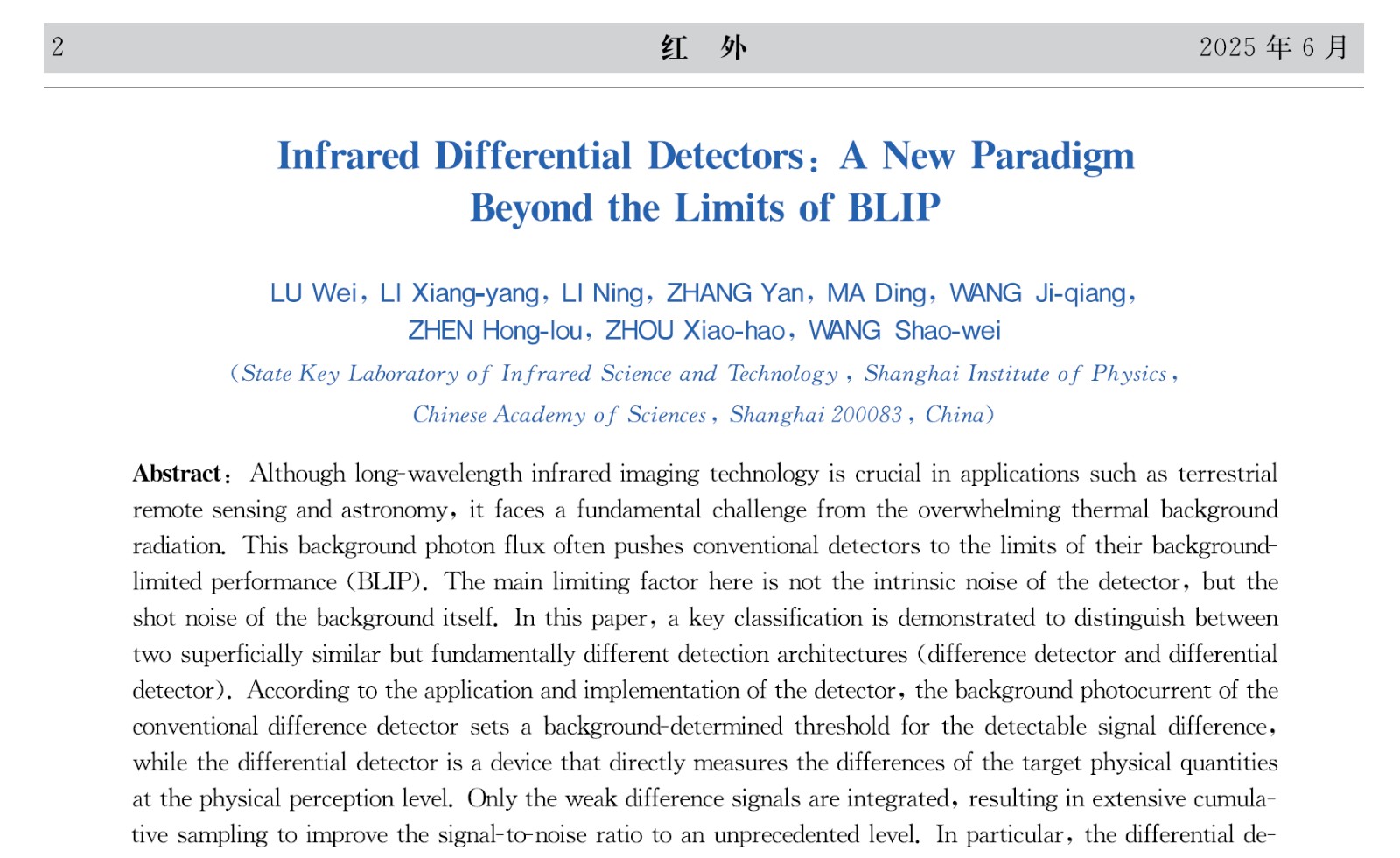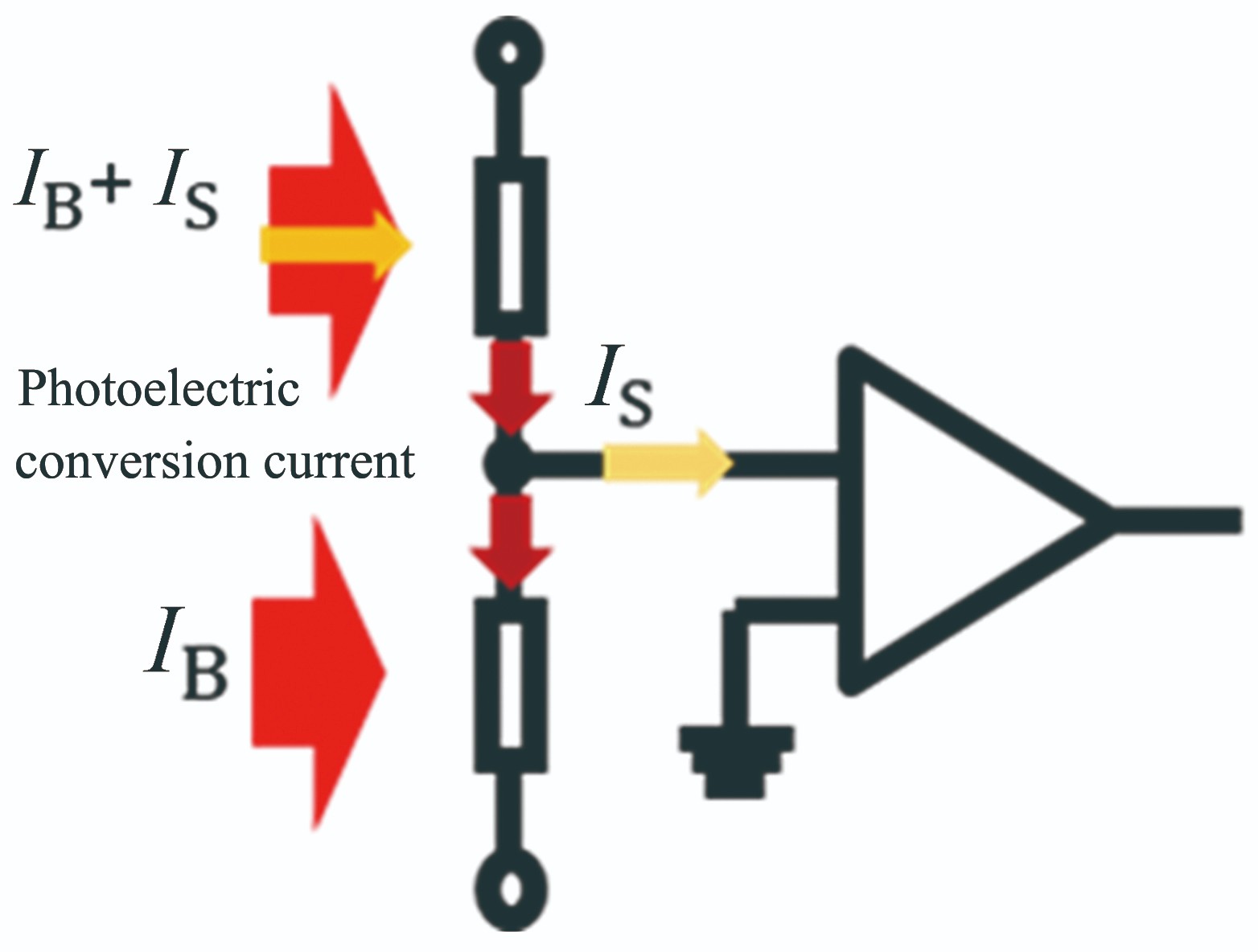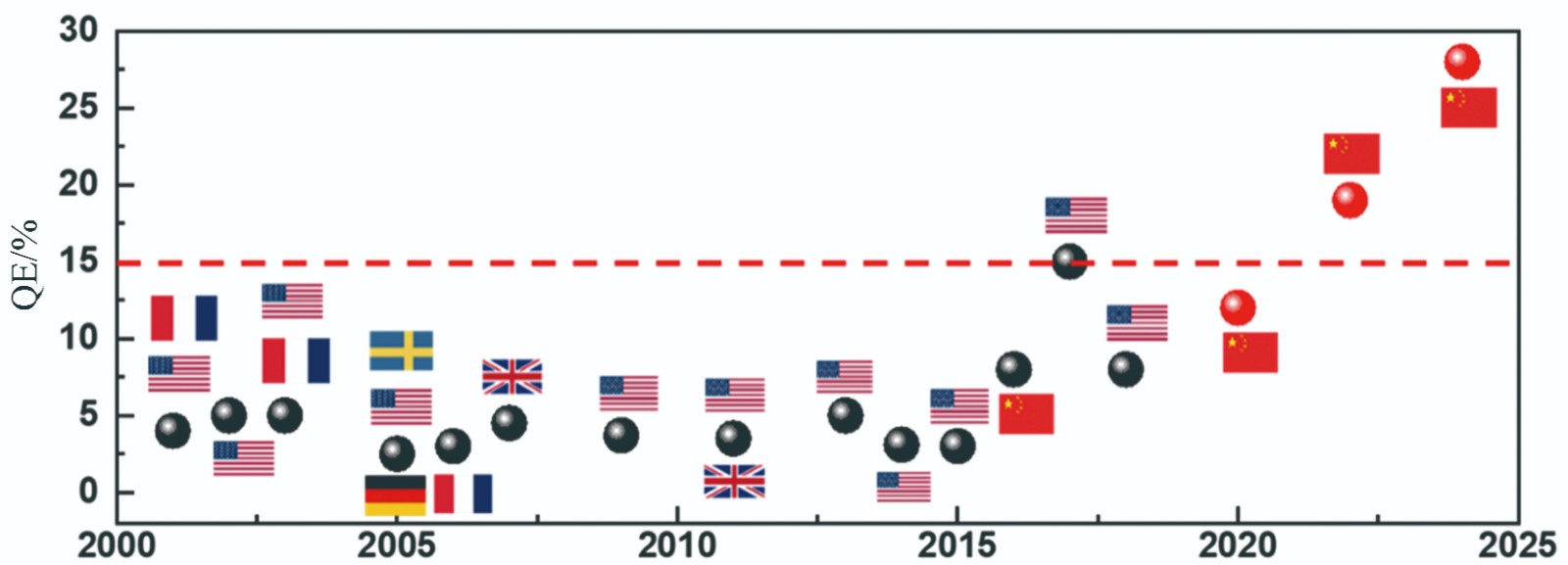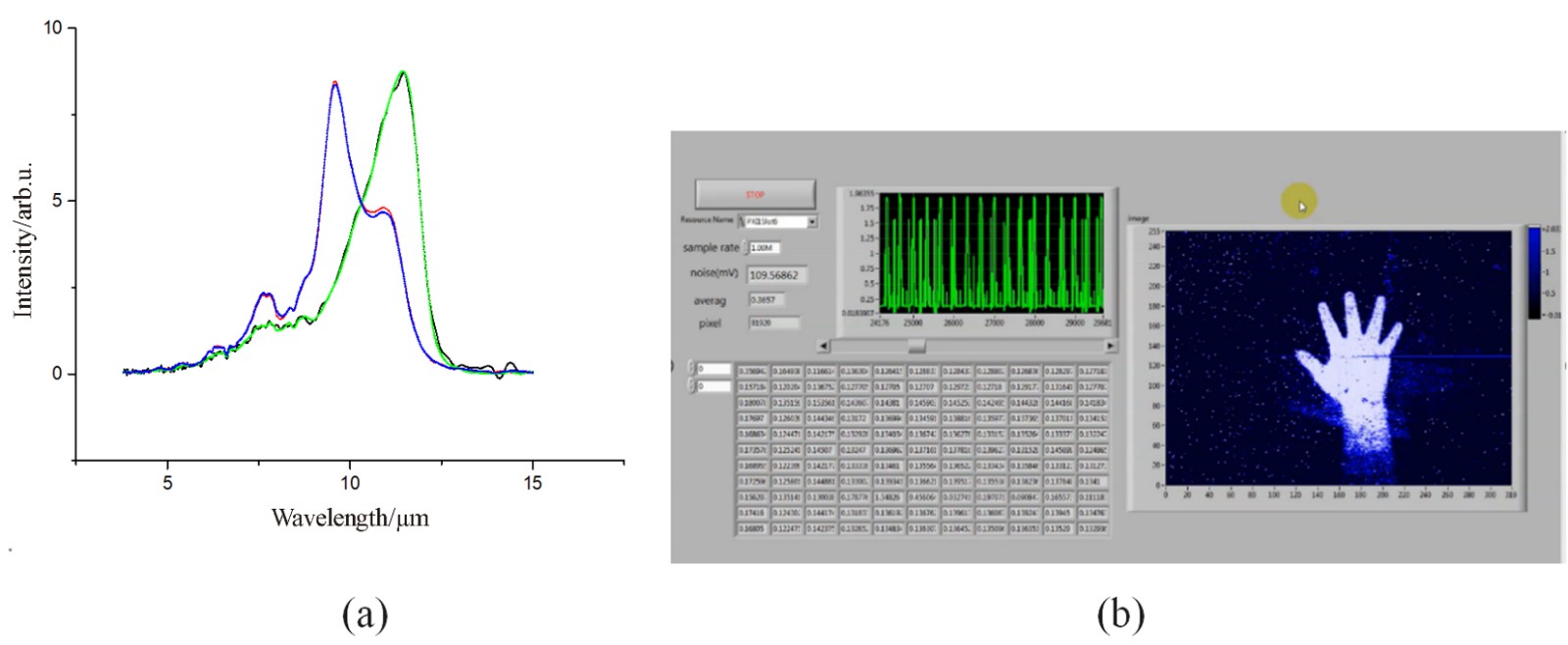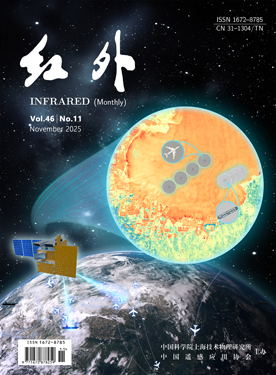- Infrared Differential Detectors: A New Paradigm Beyond the Limits of BLIP
- Infrared Differential Detectors: A New Paradigm Beyond the Limits of BLIP
- Infrared Differential Detectors: A New Paradigm Beyond the Limits of BLIP
- Infrared Differential Detectors: A New Paradigm Beyond the Limits of BLIP
- Infrared Differential Detectors: A New Paradigm Beyond the Limits of BLIP
- Current Issue
- Online First
- Most Downloaded Archive
-
2025,46(11):2-10 ,DOI: 10.11972/j.issn.1672-8785.2025.11.001
Abstract:
Currently, mass-producible passive daytime radiative cooling materials (including metamaterial films and coatings) with solar reflectivity exceeding 95% have been applied in various fields such as building thermal management and mitigation of the urban heat island effect. Previous studies have indicated that this type of technology can indirectly mitigate global warming by reducing anthropogenic greenhouse gas emissions associated with cooling energy consumption. However, quantitative research is lacking regarding the potential of large-scale radiative cooling technology to directly mitigate global warming by reducing Earth′s energy imbalance. To fill this research gap, this study aims to quantify the immediate impact of land-based large-scale radiative cooling technology on planetary albedo. Analysis shows that in most regions, the contribution of increased surface albedo to planetary albedo is significantly weakened due to the atmosphere′s shielding effect (reflection and absorption) of solar radiation reflected from the surface. Further quantitative analysis reveals that even large-cale deployment (e.g., covering 5% of the global land area) of daytime radiative cooling technology cannot directly and completely offset the currently observed trend of Earth′s energy imbalance.
-
2025,46(11):11-12 ,DOI: 10.11972/j.issn.1672-8785.2025.11.002
Abstract:
-
ZHOU Xiao-xuan, LI Li-yuan, HU Zhuo-yue, RAO Peng, LIN Chang-qing, CHEN Fan-sheng, SUN Sheng-li
2025,46(11):13-23 ,DOI: 10.11972/j.issn.1672-8785.2025.11.003
Abstract:
The rapid development of artificial intelligence has significantly enhanced the potential for target detection and tracking, but the lack of high-quality dynamic infrared datasets has limited the target perception capabilities of space-based staring detection systems. This paper proposes a construction scheme that integrates remote sensing data with physical modeling to generate a multi-frame, three-band infrared dataset containing dynamic clouds, aircraft, and ships. The cloud motion vector fields are retrieved from high-temporal-resolution geostationary observations and mapped onto the high-resolution background of the SDGSAT-1 thermal infrared spectrometer (TIS) to generate dynamic cloud fields. Simultaneously, the motion trajectories and radiation characteristics of aircraft and ships are generated based on historical TIS observations and simulation models. This dataset can be used to train and evaluate target detection and tracking models and provides data support for infrared system performance evaluation.
-
CHEN Cheng, ZANG Chi, DENG Yan-chun, ZHANG Yi-xin, GE Jian
2025,46(11):24-35 ,DOI: 10.11972/j.issn.1672-8785.2025.11.004
Abstract:
The near- to mid-infrared wavelength range contains a wealth of astrophysical information and is crucial for studying cool stars, galaxy evolution, and small bodies in the Solar System. To overcome the limitations imposed by Earth′s atmosphere, such as absorption, scattering, and thermal noise, space-based infrared survey missions have become indispensable. Since the first all-sky infrared survey mission, Infrared Astronomical Satellite (IRAS), subsequent missions such as AKARI and Wide-field Infrared Survey Explorer (WISE) have accumulated massive datasets through wide-field observations, leading to breakthroughs in areas including brown dwarf census studies, active galactic nucleus identification, and measurements of asteroid physical properties. The recently launched Spectro-Photometer for the History of the Universe, Epoch of Reionization and Ices Explorer (SPHEREx) will carry out the first all-sky near-infrared spectroscopic survey and is expected to provide new insights into the large-scale structure of the Universe, the formation history of the Milky Way and external galaxies, the distribution of interstellar ices, as well as Solar System small bodies and exoplanetary systems. This article provides a systematic review of the development of near- to mid-infrared space surveys, with a particular focus on the scientific goals, achievements, and technical characteristics of the WISE and SPHEREx missions, and offers an outlook on future advances in this field.
-
LIU Ming, MA Zhecheng, LIU Heng, TIAN Zhi-yuan
2025,46(11):36-63 ,DOI: 10.11972/j.issn.1672-8785.2025.11.005
Abstract:
Ischemia-reperfusion injury (IRI) in different organs is a common pathophysiological basis in a variety of clinical critical diseases, such as myocardial infarction, cerebral stroke, and organ transplantation. The early diagnosis and real-time monitoring of IRI is unequivocally of great significance in revealing the underlying pathogenesis, evaluating tissue activity, and improving prognosis. Near-infrared (NIR) fluorescence imaging technology has displayed great potential in investigating IRI via the manner of in vivo real-time visualization. As the cornerstone involved in such a technology, fluorescent probes play a crucial role therein, and their design strategy and performance dominantly determine the imaging specificity, sensitivity, and evaluation ability. This minireview aims to outline recent advances in research dedicated to the diagnostic applications of NIR fluorescent probes via IRI imaging, with a focus on the pathophysiological mechanism of IRI and the key biomarkers that generally act as the basis of probe design. Additionally, we classify and summarize the imaging applications of fluorescent probes according to their involvement in various IRI models of important organs, including heart, brain, lung, liver, kidney, and limbs, and give an insight into the key to design rationale and imaging performance of the probes. Finally, we present a viewpoint towards the key challenges in NIR fluorescence imaging for mapping IRI and the future research regarding developing more versatile and more efficient NIR fluorescent probes for IRI clinical imaging applications.
-
2025,46(11):64-81 ,DOI: 10.11972/j.issn.1672-8785.2025.11.006
Abstract:
This paper reviews and summarizes the development history and technical characteristics of the infrared detectors for the Fengyun meteorological satellites, and looks forward to the development trend of infrared detectors. Since the successful launch of the Fengyun-1 satellite, China′s Fengyun satellite series has become an important part of the global meteorological observation system. As one of the core components of meteorological satellite payloads, the performance improvement of infrared detectors directly affects the accuracy and timeliness of meteorological forecasts. This paper first introduces the basic principles and key technologies of infrared detectors, then sorts out the evolution process of Fengyun meteorological satellites′ infrared detectors from the early stage to the latest version, including technological innovation, performance improvements, and scale expansion. At the same time, this paper also analyzes the current technical challenges and future development directions of infrared detectors, and discusses relevant technical pathways.
-
SHEN Yue, XIE Hao, WANG Xi, LI Xun, WEI Yan-feng, CHEN Lu, LIN Chun, YE Zhen-hua
2025,46(11):82-93 ,DOI: 10.11972/j.issn.1672-8785.2025.11.007
Abstract:
Very-long-wave infrared (VLWIR) detection plays an irreplaceable role in fields such as space remote sensing, deep space exploration, and infrared spectroscopy. HgCdTe is an ideal material for VLWIR detection due to its continuously tunable bandgap. However, managing the high dark current and ensuring material uniformity, both consequences of its extremely narrow bandgap, remain core challenges. This paper first reviews the research progress of VLWIR HgCdTe detectors and the evolution of international performance evaluation standards for HgCdTe detectors. Then, it analyzes the structural evolution and operating principle of mainstream devices. Finally, an outlook on the key technological challenges and future research directions for VLWIR HgCdTe detectors is presented.
Volume 46,2025 Issue 11
Editorials
Opinion
Commentaries
Articles
Review
-
ZHANG Min, HAN Fang, KANG Jian, SUN Hao, GUO Liang, LI Chun-ling
2019,40(6):35-43
Abstract:
The characteristics of infrared thermal imaging technology are introduced, and the civilian application of infrared thermal imaging technology in civil aviation, electric power, petrochemical, forest fire prevention, medical and other civil fields is discussed. The market situation of infrared thermal imaging technology is introduced, and the development demand of infrared thermal imaging technology in different application fields are analyzed.
-
2008,29(8)
Abstract:
介绍了一种利用MATLAB和数值逼近理论计算费米函数的简捷方法.计算结果的误差在10-6数量级,甚至可以更高.与其他方法相比,该方法具有精度高、使用便捷和速度快等优点.
-
2008,29(12)
Abstract:
In this paper,the principle and features of four-wave mixing are given.The generation of four-wave mixing is derived in theory and the applications of four-wave mixing in the DWDM for optical fiber communication,phase conjugation wave generation and real time optical detection are given.The study in this paper is aimed at more completely knowing the application direction of the four-wave mixing, a typical nonlinear optical effect and finding more applications for the four-wave mixing by summing up the existing relatively mature applications and research methods.
-
Nie Jianhua, Liu Jiaqing, Meng Xin, Han Shunli
2019,40(6):44-48
Abstract:
In order to realize the reasonable classification of optical spectrometers, the classification study is carried out from the working band and spectroscope of the spectrometer. On the basis of in-depth research on the development status of existing spectrometer products at home and abroad, the related research is summarized and analyzed, and the specific classification methods and classification results are given. At the same time, by using known spectrometry technology and the research result, the comparative research conclusions of spectrometers are introduced, and the key technologies and core components are pointed out. This conclusion can provide spectrometer researchers with a panoramic viewing angle and also provide a valuable reference for tracking industry development.
-
2010,31(3):42-46
Abstract:
According to the finite difference principle, a one-dimensional Schr\"{o}dinger equation can be converted into a set of nodal linear equations expressed in a matrix equation after the space is divided into a series of discrete nodes with an equal interval. The matrix left division command offered in the MATLAB software can be used to derive the function approximation of each unknown nodal function. This method is simple in concept, convenient in operation and can solve large linear equations without more efforts in programming.
-
2019,40(7):35-46
Abstract:
The noise sources and denoising methods of functional near-infrared spectroscopy (fNIRS) brain imaging are reviewed. The method and operation of suppressing noise are analyzed and given from the aspects of imaging principle, noise source and occurrence mechanism. The composition and characteristics of the interference are analyzed in detail, the effective removal method is given, and the signal quality algorithm in the process of brain imaging analysis and modeling of near-infrared spectroscopy is improved. These methods can provide guidance for the analysis and processing of near-infrared spectroscopy brain imaging data. Three noise sources that affect near-infrared spectroscopy brain imaging signals are summarized: instrumental noise, experimental error and physiological interference from the body. Two practical denoising algorithms are given and the development trend of imaging technology is expounded.
-
2008,29(12)
Abstract:
The good properties of THz wave and how to use photoconductive antenna and optical rectification to generate THz wave are described in detail.The applications of THz wave in long distance surveillance,imaging,exploder distinguishing,nondistructive inspection and particularly in the field of military are presented.
-
GUO Xiao-Dong, ZUO Zhi-Gao, YUE Song, HONG Pu
2019,40(7):18-25
Abstract:
The theoretical model of infrared point target detection system is systematically analyzed. The transmittance of medium-wave and long-wave infrared light under typical atmospheric conditions is calculated by establishing the atmospheric stratification model and combining the MODTRAN model. The comparison data of the two calculation results can provide reference for the band selection in the design of infrared detection system. By analyzing the theoretical model of infrared radiation intensity of targets, the infrared radiation intensity of several typical targets in different wavebands is calculated, which provides support for the demonstration of operation range for IR system. Based on the probability density distribution function of infrared image noise, the theoretical formulas of image signal-to-noise ratio, system detection probability and false alarm probability are derived, which provide reference for setting detection threshold. The theoretical model analysis results of infrared point target detection system''s operation range can offer an important theoretical support for improving the credibility of infrared detection system''s operation range demonstration and the rationality of system parameter design.
-
2010,31(3):11-14
Abstract:
The typhoon center is usually located manually by meteorologists. This location method has a low degree of automation. According to the movement characteristics of typhoon and the meteorological analysis theory, a single infrared satellite cloud image is used to establish a method for extracting the dominant cloud movement vectors. On this basis, the optimal target function for locating the typhoon center automatically is set and resolved. The automatical location of the typhoon with an eye or without an eye is realized. The method is used to simulate the automatical location of the center of typhoon ``HAITANG' in several cloud images obtained in 2005. The result shows that this method has a high location accuracy and can be used as a good technical means for the automatical location of typhoon center.
-
2019,40(6):27-34
Abstract:
From the perspective of theoretical numerical simulation and near-field radiation experimental research, the latest research results in near-field thermal radiation heat transfer are introduced. The focus of theoretical research is mainly on heat transfer studies in graphene composites, artificial processing and synthetic metamaterials. The focus of experimental research is on laboratory equipment manufacturing and method innovation based on nanoscale near-field thermal radiation measurements. Very near-field thermal radiation measurements with a minimum distance of only 2 nm have been experimentally implemented. Further research on near-field thermal radiation provides a theoretical basis for thermal photovoltaic, radiant cooling and efficient energy harvesting applications.
-
wngxinkun, zhaofang, wangjianjiang
2019,40(7):1-11
Abstract:
With the advent of various new types of detection radars, advanced infrared detectors and precision guided weapons, infrared & radar compatible stealth materials have become the focus of current stealth technology research. The stealth principle and research status of traditional and new infrared & radar compatible stealth materials are reviewed, and the development direction of future infrared & radar compatible stealth materials is summarized and forecasted.
-
2013,34(7):15-19
Abstract:
Starting from the Schrodinger equation, the influence of different Al composition and different temperatures on the absorption spectra of wide quantum well infrared photodetectors (QWIP) is studied. It is found that when the Fermi level is fixed, the ground state bound energy of the quantum well may increase with the increasing of the Al composition and the corresponding absorption spectral peak tends to move toward the short wave. In addition, the influence of the ambient temperature on the response spectra of AlGaAs/GaAs QWIPs is negligible. After theoretical calculation, the rule of the absorption spectrum of an AlGaAs/GaAs QWIP changing with quantum well width, Al composition and temperature is given.
-
Gao Yuxuan, Chen Xingming, Dai Jun, Yang Meixia, Huang Shoubin, Chen Xiang, Hou Zhenyan, Huang Jian
2023,44(4):20-32
Abstract:
Focusing is a key part of the launch focusing device in highenergy laser systems, and the focusing mechanism plays an important role in the targeting and striking accuracy of the system. In order to understand the research status and development trend of focusing mechanism, various types of foreign mature focusing mechanisms are introduced firstly. The principle of their focusing control and the solutions of various technical problems are analyzed. The domestic research situation focuses on four types of focusing mechanisms: cam, screw, worm gear and direct drive. For each form of focusing mechanism, the basic principle of controlling focusing is analyzed, and the design features of the focusing mechanism applied to different systems are introduced. By analyzing the design and control of each type of focusing mechanism, the advantages and disadvantages are summarized and compared, and the design ideas and research directions of the focusing mechanism for high-energy laser systems are proposed to lay the technical foundation for the research on focusing mechanism of high-energy laser systems.
-
2011,32(8):25-28
Abstract:
Sea-sky-line detection can be implemented by effectively suppressing the background and enhancing the target in an image according to the features of sea-sky environment. An improved method for wiping off crass points is proposed on the basis of the linear fitting algorithm. The method is simulated with the Matlab software. The simulation result shows that this improved method can effectively detect the positions of the sea-sky-line and ships against the sea-sky background. It provides a good basis for target recognition and image registration.
-
2008,29(12)
Abstract:
第一部分 一、探测与识别 1.高光谱图像的结构模型中正交子空间投影探测器与匹配滤光片的分析比较(P.Bajorski,美国罗彻斯特理工学院)
-
PAN Ming-zhong, QI Hong-xing, XIAO Gong-hai, SHU Rong
2010,31(1):1-7
Abstract:
A compact field hyperspectral imaging spectrometer based on a prism-grating-prism structure is presented. The system is designed for the wavelength range from visible light to near infrared. It has 344 spectral bands with the spatial resolution higher than 10 nm and the spectral resolution higher than 1 mrad. To study the unmixing of mixed pixels, the basic principle of the field hyperspectral imaging spectrometer is described, the main specifications of the system is analyzed, the design of the system is discussed in detail and related tests are conducted. The test results show that the system has both higher spatial resolution and higher spectral resolution. Because of its compactness and reliable operation, it is very suitable for field applications. Thus, the feasibility of the use of a compact field hyperspectral imaging spectrometer in the research on the unmixing of mixed pixels is verified.
-
2008,29(8)
Abstract:
本文研究由介电系数和磁导率为负的材料组成的一维光子晶体中的电磁波脉冲的传播特性.利用传输矩阵的方法,计算出了该结构中脉冲传播的透射谱和相时间.数值结果表明,在光子带隙的带边和带底会分别出现脉冲传播速度减慢和加快的现象.若周期结构中间存在缺陷层,光子带隙中会出现极窄的透射峰,因此,对应于该频率的电磁波在该体系中传播时速度会变得更加缓慢.
-
WUWEI, HANSHUNLI, HOUXIBAO, LIULEI, XIANGGUOQING
2017,38(6):1-7
Abstract:
According to the spectral response curves and dark current of a near infrared two-dolor detector in two different operation wavebands, a signal acquisition system based on the near infrared two-color detector is designed. The system has many current-voltage conversion levels, voltage amplification levels and filter circuit bandwidth levels. It can amplify signals and control bandwidth quickly. Moreover, it provides zero analog signals for four amplify circuits via a Digital-to-Analog (D/A) convertor. This can effectively eliminate the noises caused by the stray light and the dark current of the detector itself. The system has the features of high speed, low noise and high resolution. By using this signal acquisition system, many parameters of the optical system, such as signal-to-noise ratio, dynamic range and minimum measurable power, can be improved.
-
2016,37(4):27-32
Abstract:
An algorithm combining Light of Sight (LOS) with the OpenGL software interface is proposed. The method uses the depth measuring and occlusion query functions of the OpenGL software interface to determine the effective emission surface in the detection direction and the transfer path of its radiation in mediums. Then, it uses LOS to obtain the radiation characteristics of the target in atmosphere in the detection direction. The simulation result shows that this algorithm is effective and has high computation efficiency.
-
BAI Wei, ZHAO Chao, GONG Zhi-hong
2017,38(1):6-11
Abstract:
Combining with the X-ray diffraction technique and the layer-by-layer chemical etch method for peeling damage layers, the depth of the damage layer in InSb crystal introduced by cutting, lapping and polishing was analyzed quantitatively. The structures and causes of damage layers were discussed. The research result showed that cutting was the major process for introducing damage layer on the surface of InSb wafers. The depth of the damage layer introduced by cutting was up to 16 microns. The depth of the damage layer introduced by double-face lapping was about 12 microns. The depth of the damage layer introduced by mechanical-chemical polishing obviously decreased. It was about 2 microns.
